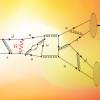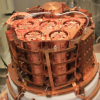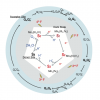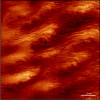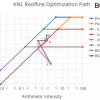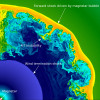Science News
Novel Calculation Sheds New Light on Matter/Anti-Matter Mystery
An international collaboration of theoretical physicists has published a novel calculation that provides new insights into the relationship between matter and antimatter in the universe. This work included extensive use of NERSC supercomputing resources over six years. Read More »
Deep-Learning Research Nominated for Best Student Paper Award at SC20
A paper describing MeshfreeFlowNet — an open-source, physics-constrained, deep-learning approach for simultaneously enhancing the spatial and temporal resolution of scientific data — is a finalist for the Best Student Paper Award at SC20.“MeshfreeFlowNet is a big step forward in terms of physics-constrained machine learning algorithm development, combining important criteria necessary for scientific data: physics-based partial differential equation constraints, a mesh-free design that… Read More »
NERSC Supports COVID-19 Pandemic Response
Since April 2020, NERSC has allotted 2.5 million node hours on its Cori supercomputer and has provided dedicated HPC staff liaisons and other resources to support COVID-19 research. Read More »
Physical Scientists Turn to Deep Learning to Improve Earth Systems Modeling
The role of deep learning in science is at a turning point, with weather, climate, and Earth systems modeling emerging as an exciting application area for physics-informed deep learning. In this Q&A, NERSC's Karthik Kashinath discusses what is driving the scientific community to embrace these new methodologies. Read More »
NERSC Resources Play Key Role in CUPID-Mo Collaboration
Nuclear physicists affiliated with the U.S. Department of Energy’s Lawrence Berkeley National Laboratory (Berkeley Lab) played a leading role in analyzing data for a demonstration experiment that has achieved record precision for a specialized detector material. The data-analysis component of this ground-breaking research was conducted entirely at the National Energy Research Scientific Computing Center (NERSC), a DOE Office of Science user facility located at Berkeley Lab. Read More »
Spectacular ultraviolet flash may finally explain how white dwarfs explode
For just the second time ever, astrophysicists have spotted a spectacular flash of ultraviolet light in a supernova, an extremely rare event following a white dwarf explosion. Read More »
Supercomputing Pipeline Aids DESI’s Quest to Create 3D Map of the Universe
The Dark Energy Spectroscopic Instrument is combining high-speed automation, high-performance computing, and high-speed networking to produce the largest 3D map of the universe ever created. Starting in late 2020, DESI's five-year mission is to capture light from 35 million galaxies and 2.4 million quasars and transmit that data to NERSC - DESI’s primary computing center - for data processing and analysis. Read More »
Making Quantum ‘Waves’ in Ultrathin Materials
Running calculations at NERSC, a team of researchers co-led by Berkeley Lab have revealed how wavelike plasmons could power up a new class of sensing and photochemical technologies at the nanoscale. Read More »
Machine Learning Could Provide Unexpected Scientific Insights into COVID-19
A new text-mining tool developed at Berkeley Lab and supported by NERSC supercomputing resources is using natural language processing techniques that could yield unexpected scientific insights into COVID-19. Read More »
World's First 3D Simulations of Superluminous Supernovae
For the first time ever, an international team of astrophysicists simulated the 3D physics of superluminous supernovae—which are about a hundred times more luminous than typical supernovae—with NERSC supercomputers and the CASTRO code. Read More »
Harnessing the Power of Exascale for Wind Turbine Simulations
ExaWind, a DOE Exascale Computing Project, is developing new simulation capabilities to more accurately predict the complex flow physics of wind farms, and Berkeley Lab is bringing its adaptive mesh refinement expertise to the project to help make this happen. Read More »
NERSC’s Scientific Computing Power Steps into Coronavirus Battle
Researchers from the City of Hope’s Beckman Research Institute and the Translational Genomics Research Institute will use NERSC computing resources to help battle the COVID-19 global pandemic. Read More »
Earlier Spring Foliage Brings Warmer Air to the North
A group of researchers used NERSC to explore how early leaf growth, or “leaf-out,” affects the earth’s ecosystem. Their findings show that early spring leaf-out is causing a definitive increase in annual surface warming in the Northern Hemisphere. Read More »
Berkeley Lab Collaborates to Prepare Photovoltaic Materials Research for Exascale
NERSC and CRD researchers are part of a collaboration that is using BerkeleyGW software to enhance the search for new, more efficient photovoltaic solar cell materials on the first exascale computers. Read More »
NOAA Releases Extended Version of 20th Century Reanalysis Project
Calling it a time machine for weather data and a treasure trove for climate researchers, the National Oceanic and Atmospheric Administration (NOAA) has released an updated version of the 20th Century Reanalysis Project (20CRv3) - a high-resolution, four-dimensional reconstruction of the global climate that estimates what the weather was every day back to 1806. The release of this latest 20CRv3 data comes on the heels of an October 2019 release of data going back to 1836. Together these new… Read More »
Deep Learning Expands Study of Nuclear Waste Remediation
A research collaboration between Berkeley Lab, Pacific Northwest National Laboratory, Brown University, and NVIDIA has achieved exaflop performance with a deep learning application used to model subsurface flow in the study of nuclear waste remediation. Read More »
NERSC Powers Research on Post-Wildfire Water Availability
Scientists at Berkeley Lab recently took a closer look at how wildfires affect California’s watersheds. Computer simulations run at NERSC allowed them to identify the regions in the watershed that were most sensitive to wildfire conditions, as well as the hydrologic processes that are most affected. Read More »
NERSC Resources Help PPPL Team Predict Plasma Pressure in Future Fusion Facilities
Researchers at the Princeton Plasma Physics Laboratory have developed new insights into the physics governing the balance of pressure in the scrape-off layer, the thin strip of gas at the edge of the plasma in a tokamak reactor. Read More »
Hydrogen a Culprit in Capacity Loss of Sodium-Ion Batteries
Using NERSC's Cori system, UC Santa Barbara computational materials scientist Chris Van de Walle and colleagues have uncovered a reason for the loss of capacity that occurs over time in sodium batteries. Read More »
Berkeley Lab Deep Learning Expertise Draws Attention at International Climatology Meeting
Berkeley Lab’s growing expertise in applying machine learning methods to extreme weather event studies led to invitations to present at the 2019 International Meeting on Statistical Climatology, a prestigious event held only every three years. Read More »
Scientists Piece Together the Largest U.S.-Based Dark Matter Experiment
Most of the remaining components needed to fully assemble an underground dark matter-search experiment called LUX-ZEPLIN (LZ) arrived at the project’s South Dakota home during a rush of deliveries in June. Once it is up and running, data captured by the detectors’ electronics will ultimately be transferred to NERSC, LZ’s primary data center, via ESnet. Read More »
Three Sky Surveys Completed in Preparation for Dark Energy Spectroscopic Instrument
It took three sky surveys – conducted at telescopes in two continents, covering one-third of the visible sky, and requiring almost 1,000 observing nights – to prepare for a new project that will create the largest 3D map of the universe’s galaxies and glean new insights about the universe’s accelerating expansion. Read More »
NERSC’s Cori System Reveals Integral Role of Gluons in Proton Pressure Distribution
For the first time, lattice quantum chromodynamics calculations run at NERSC allowed nuclear physicists from the Massachusetts Institute of Technology to determine the pressure distribution inside a proton, taking into account the contributions of the proton’s fundamental particles: quarks and gluons. Read More »
Cleaning Cosmic Microwave Background Data to Measure Gravitational Lensing
Gravity from distant galaxies cause tiny distortions in cosmic microwave background temperature maps - a process called gravitational lensing - which are detected by data analysis software run on supercomputers like the Cori system at NERSC. Unfortunately, this temperature data is often corrupted by foreground emissions from extragalactic dust, gas, and other noise sources that are challenging to model. So Berkeley Lab researchers developed a statistical method for analyzing CMB data that is largely immune to the foreground noise effects. Read More »
CosmoGAN: Training a Neural Network to Study Dark Matter
A Berkeley Lab-led research group is using a deep learning method known as generative adversarial networks to enhance the use of gravitational lensing in the study of dark matter. Read More »
Superfacility Framework Advances Photosynthesis Research
Researchers have long studied PSII, a protein complex in green plants, algae, and cyanobacteria that plays a crucial role in photosynthesis. Their understanding of this three-billion-year-old biological system is now moving more quickly, thanks to an integrated superfacility framework established between LCLS, ESnet, and NERSC. Read More »
A Breakthrough in the Study of Laser/Plasma Interactions
A new 3D particle-in-cell simulation tool developed by researchers from Lawrence Berkeley National Laboratory and CEA Saclay is enabling cutting-edge simulations of laser/plasma coupling mechanisms that were previously out of reach of standard PIC codes used in plasma research. Read More »
2019 DOE Performance Portability Meeting Breaks New Ground
The 2019 DOE Performance, Portability, and Productivity Annual Meeting once again brought together representatives from national labs, academia, and the vendor community to share ideas, progress, and challenges in achieving performance portability across DOE’s current and future supercomputers. Read More »
Searching for Photocathodes that Convert CO2 into Fuels
As scientists search for new materials to enable the photocatalytic conversion of CO2, a Berkeley Lab team used supercomputing resources at NERSC to perform a massive photocathode search, starting with 68,860 materials and screening them for specific intrinsic properties. Read More »
When Stars Collide: 3D Computer Simulation Captures Cosmic Event
The aftermath of the collision of two neutron stars has been fully captured in a 3D computer model for the first time, thanks to research by University of Alberta astrophysicist Rodrigo Fernández and an international team. Read More »
Revealing Reclusive Recombination Mechanisms in Solar Cell Materials
Researchers at UCSB used NERSC supercomputers to better understand key mechanisms behind the solar conversion efficiencies of hybrid perovskites, which could make these materials even more attractive for photovoltaics. Read More »
Shedding New Light on Luminous Blue Variable Stars
Three-dimensional simulations run at NERSC, Argonne and NASA have provided new insights into the behavior of a unique class of celestial bodies known as luminous blue variables - rare, massive stars that can shine up to a million times brighter than the Sun. Read More »
Simulations Run at NERSC Confirm Thermal and Electrical Properties of Superionic Crystals
Using a combination of experiments and simulations, materials scientists at Duke University, Oak Ridge National Laboratory and Argonne National Laboratory have sussed out the physical phenomenon underlying the promising electrical and thermal properties of a class of materials called superionic crystals. Read More »
Berkeley Lab, Oak Ridge, NVIDIA Team Breaks Exaop Barrier With Deep Learning Application
A team of computational scientists from Berkeley Lab and Oak Ridge National Laboratory and engineers from NVIDIA has, for the first time, demonstrated an exascale-class deep learning application that has broken the exaop barrier. Read More »
HP-CONCORD Paves the Way for Scalable Machine Learning in HPC
A team of Berkeley Lab researchers has demonstrated how a new parallel algorithm called HP-CONCORD can help address some of the most challenging problems in data-driven science. Read More »
NERSC, Intel, Cray Harness the Power of Deep Learning to Better Understand the Universe
A Big Data Center collaboration between computational scientists at NERSC and engineers at Intel and Cray has yielded another first in the quest to apply deep learning to data-intensive science: CosmoFlow, the first large-scale science application to use the TensorFlow framework on a CPU-based high performance computing platform with synchronous training. Read More »
Topology, Physics & Machine Learning Take on Climate Research Data Challenges
Two PhD students who first came to Berkeley Lab as summer interns in 2016 are spending six months a year at the lab through 2020 developing new data analytics tools that could dramatically impact climate research and other large-scale science data projects. Read More »
Berkeley Lab Researchers Showcase Deep Learning for High Energy Physics at CHEP
Steve Farrell, a machine-learning engineer who recently joined NERSC, gave an overview of Berkeley Lab’s expanding expertise in deep learning for science during a plenary talk at the 2018 CHEP conference in July. Read More »
Batteries Get a Boost from ‘Pickled’ Electrolytes
Battery researchers at Argonne National Laboratory used computer simulations to help reveal the mechanism behind a common additive known to extend the life of lithium-ion batteries. Read More »
Berkeley Lab-Developed Digital Library is a Game Changer for Environmental Research
Developed by Berkeley Lab, NERSC and NCEAS researchers, ESS-DIVE is a new digital archive that serves as a repository for hundreds of U.S. Department of Energy-funded research projects under the agency’s Environmental System Science umbrella. Read More »
IceCube Neutrinos Point to Long-Sought Cosmic Ray Accelerator
An international team of scientists has found the first evidence of a source of high-energy cosmic neutrinos, ghostly subatomic particles that can travel unhindered for billions of light years from the most extreme environments in the universe to Earth. Read More »
NOvA experiment sees strong evidence for antineutrino oscillation
The Fermilab NOvA neutrino experiment announced that it has seen strong evidence of muon antineutrinos oscillating into electron antineutrinos over long distances, a phenomenon that has never been unambiguously observed. Image: Sandbox Studio Read More »
New Simulations Break Down Potential Impact of a Major Quake by Building Location and Size
A team of Berkeley Lab and LLNL researchers is leveraging powerful supercomputers at NERSC to portray the impact of high-frequency ground motion on thousands of representative different-sized buildings spread out across the California region. Read More »
Berkeley Researchers Use Machine Learning to Search Science Data
Science Search, a web-based search engine for scientific data is currently being developed by a team of researchers in Berkeley Lab's CRD and NERSC. The team is also developing innovative machine learning tools to pull contextual information from scientific datasets and automatically generate missing metadata tags for each file. As a proof-of-concept, the team is working with staff at the Molecular Foundry, to demonstrate the concepts of Science Search on the images captured by the facility's instruments. Read More »
Self-Healing Cement Could Be a Boon to Oil & Gas Industry
Researchers at Pacific Northwest National Laboratory have developed a unique cement that can repair itself in as little as a few hours; simulations run at NERSC helped them understand how it works. Read More »
Quarterbacking Catalysts by Positioning Atoms
Materials science researchers at Pacific Northwest National Laboratory used experiments involving graphene, along with calculations run at NERSC, to better understand how oxygen atoms bind with graphene and turn graphene into a unique catalytic support. Read More »
Tiny Distortions Reveal Clearer Picture of Strands in Cosmic Web
Scientists have decoded faint distortions in the patterns of the universe’s earliest light to map huge tubelike structures invisible to our eyes – known as filaments – that serve as superhighways for delivering matter to dense hubs such as galaxy clusters. Read More »
Deep Learning at 15 PFlops Enables Training for Extreme Weather Identification at Scale
Petaflop per second deep learning training performance on the Cori supercomputer at NERSC has given climate scientists the ability to use machine learning to identify extreme weather events in huge climate simulation datasets. Read More »
Underground Neutrino Experiment Could Provide Greater Clarity on Matter-Antimatter Imbalance
A new underground neutrino experiment could provide greater clarity on matter-antimatter imbalance in the Cosmos. And NERSC will be the principal site for data processing and analyses throughout the course of the experiment. Read More »
NERSC Supercomputers Help Researchers Create Reference Catalog for Rumen Microbiome
Using supercomputers at NERSC, an international team led by William Kelly, formerly at AgResearch New Zealand’s Grasslands Research Centre, and including scientists at the Joint Genome Institute generated a reference catalog of rumen microbial genomes and isolates cultivated and sequenced from the Hungate1000 collection. Read More »
A Game Changer: Metagenomic Clustering Powered by HPC
A team of researchers from Berkeley Lab's CRD and JGI took one of the most popular clustering approaches in modern biology—the Markov Clustering algorithm—and modified it to run quickly, efficiently and at scale on distributed-memory supercomputers. Read More »
Can Strongly Lensed Type Ia Supernovae Resolve One of Cosmology’s Biggest Controversies?
Using the SciDAC developed SEDONA code and NERSC supercomputers, astrophysicists at Berkeley Lab and the University of Portsmouth discovered how to control the effects of "micolensing." Armed with this knowledge they believe they will be able to find 1000 strongly lensed Type Ia supernovae in real-time from LSST data--that's 20 times more than previous expectations. Read More »
The Atomic Dynamics of Rare Magneto-Electric Matter
By ricocheting neutrons off the atoms of yttrium manganite (YMnO3) heated to 3,000 degrees Fahrenheit, researchers have discovered the atomic mechanisms that give the unusual material its rare electromagnetic properties. Their work included quantum simulations run at NERSC. Read More »
Physics Data Processing at NERSC Dramatically Cuts Reconstruction Time
In a recent demonstration project, physicists from Brookhaven National Laboratory and Berkeley Lab used the Cori supercomputer to reconstruct data collected from a nuclear physics experiment, an advance that could dramatically reduce the time it takes to make detailed data available for scientific discoveries. Read More »
Delivering Efficient Parallel I/O with HDF5 on Exascale Computing Systems
In an interview with Department of Energy's ECP communications team, Berkeley Lab's Suren Byna and Quincey Koziol talk about delivering efficient parallel I/O with HDF5 on exascale computing systems. Read More »
Berkeley Lab Physicists Apply Machine Learning to the Universe’s Mysteries
Berkeley Lab physicists and their collaborators have demonstrated that computers are ready to tackle the universe’s greatest mysteries – they used neural networks to perform a deep dive into data simulating the subatomic particle soup that may have existed just microseconds after the big bang. Read More »
Charting a New Course in Organic Solar Cell Design
Scientists have pinpointed the source of an ultrafast and efficient process that spawns several carriers of electrical charge from a single particle of light in organic crystals that are integral to this increasingly popular form of solar cells. Read More »
Coupling Experiments to Theory to Build a Better Battery
A research team led by Berkeley Lab found that a new lithium-sulfur battery component allows a doubling in capacity compared to a conventional lithium-sulfur battery. Read More »
The Blob that Ate the Tokamak
Scientists at Princeton Plasma Physics Laboratory used NERSC resources to create new simulations that could provide insight into how blobs (bubbles) at the plasma edge in a tokamak reactor behave. Read More »
Creating a World of Make-Believe to Better Understand the Real Universe
Seeing is believing, or so the saying goes. And in some cases, a world of make-believe can help you realize what you’re actually seeing, too. Scientists are creating simulated universes, for example – complete with dark matter mock-ups, computer-generated galaxies, quasi quasars, and pseudo supernovae – to better understand real-world observations. Their aim is to envision how new Earth-based and space-based sky surveys will see the universe, and to help analyze and interpret the vast… Read More »
Heavy Metal: How First Supernovae Altered Early Star Formation
An international team of researchers ran multi-scale, multi-physics 2D and 3D simulations at NERSC to illustrate how heavy metals expelled from exploding supernovae helped the first stars in the universe regulate subsequent star formation and influence the appearance of galaxies in the process. Read More »
High-Performance Computing Cuts Particle Collision Data Prep Time
For the first time, scientists have used high-performance computing to reconstruct the data collected by a nuclear physics experiment—an advance that could dramatically reduce the time it takes to make detailed data available for scientific discoveries. Read More »
NERSC Resources Help Predict New Material for High-Power, High-Efficiency LEDs
Using predictive atomistic calculations and high-performance supercomputers at NERSC, University of Michigan researchers found that incorporating the element boron into the widely used InGaN (indium-gallium nitride) material can keep electrons from becoming too crowded in LEDs, making the material more efficient at producing light. Read More »
Detailed View of Immune Proteins Could Lead to New Pathogen-Defense Strategies
Researchers at Berkeley Lab and UC Berkeley used cryo-electron microscopy to capture a high-resolution image of a protein ring called an “inflammasome” as it was bound to flagellin, providing new insight into potential strategies for protection from pathogens. Read More »
Deep Learning for Science: A Q&A with NERSC’s Prabhat
In this Q&A with Prabhat, who leads the Data and Analytics Services Group at NERSC and has been instrumental in several projects exploring opportunities for deep learning in science, he talks about the history of deep learning and machine learning and the unique challenges of applying these data analytics tools to science. Read More »
The Mystery of the Star That Wouldn’t Die
Supercomputers at NERSC helped an international team of scientists decipher one of the most bizarre spectacles ever seen in the night sky: A supernova that refused to stop shining, remaining bright far longer than an ordinary stellar explosion. What caused the event is puzzling. Read More »
Solving a Magnesium Mystery in Rechargeable Battery Performance
Simulations run at NERSC helped a research team at the Joint Center for Energy Storage Research discover a surprising set of chemical reactions involving magnesium that degrade battery performance even before the battery can be charged up. Read More »
Scientists Decode the Origin of Universe’s Heavy Elements in the Light from a Neutron Star Merger
Scientists have obtained the first measurement of the merger of two neutron stars and its explosive aftermath. Computer simulations at NERSC were critical for understanding the event, which could provide valuable insights into the origin of universe’s heavy elements. Read More »
Assessing Regional Earthquake Risk and Hazards in the Age of Exascale
Researchers from Berkeley Lab, Lawrence Livermore Lab and UC Davis are using supercomputers at NERSC to build the first-ever end-to-end simulation code to precisely capture the geology and physics of regional earthquakes, and how the shaking impacts buildings. Read More »
A TOAST for Next Generation CMB Experiments
Computational cosmologists at Berkeley Lab they recently achieved a critical milestone in preparation for upcoming CMB experiments: scaling their data simulation and reduction framework TOAST to run on all 658,784 Intel Knights Landing Xeon Phi processor cores on the NERSC’s Cori. The team also implemented a new TOAST module to simulate the noise introduced when ground-based telescopes look at the CMB through the atmosphere. Read More »
Multiscale Simulations Help Predict Unruly Plasma Behavior
New multiscale gyrokinetic simulations are making it easier to more accurately predict plasma behavior in a tokamak reactor. Read More »
NERSC Supercomputers Help Berkeley Lab Scientists Map Key DNA Protein Complex
Using cryo-electron microscopy and supercomputing resources at NERSC, Berkeley Lab scientists have obtained 3-D models of a human transcription factor at near-atomic resolutions. Read More »
A First: Trapping Noble Gases in 2D Porous Structures at Room Temp
A materials science breakthrough at the nanoscale could lead to better methods for capturing noble gases, such as radioactive krypton and xenon generated by nuclear power plants. Read More »
Simulations Show How Recycled Atoms Boost Plasma Turbulence
Using NERSC's Edison supercomputer, physicists at Princeton Plasma Physics Laboratory have modeled how recycled neutral atoms, which arise when hot plasma strikes a tokamak fusion reactor’s walls, increase plasma turbulence driven by what is called the “ion temperature gradient.” Read More »
New Simulations Could Help in Hunt for Massive Mergers of Neutron Stars, Black Holes
Working with an international team, Berkeley Lab scientists have developed new computer models to explore what happens when a black hole joins with a neutron star – the superdense remnant of an exploded star. Read More »
'Hindcasting' Study Investigates the Extreme 2013 Colorado Flood
Using a publicly available climate model, Berkeley Lab researchers “hindcast” the conditions that led to the Sept. 9-16, 2013 flooding around Boulder, Colo. and found that climate change attributed to human activity made the storm much more severe than would otherwise have occurred. Read More »
Record-setting Seismic Simulations Run on NERSC’s Cori System
Record-setting seismic simulations run earlier this year on the Cori supercomputer at NERSC were the subject of two presentations at the ISC High Performance conference in Frankfurt, Germany this week. Read More »
Simulations Pinpoint Atomic-level Defects in Solar Cell Nanostructures
Heterogeneous nanostructured materials are widely used in various optoelectronic devices, including solar cells. However, the nano-interfaces contain structural defects that can affect the performance of optoelectronic devices. Running calculations at NERSC, researchers found the root cause of the defects in two materials and provided design rules to avoid them. Read More »
Record-breaking 45-qubit Quantum Computing Simulation Run at NERSC on Cori
Researchers from ETH Zurich in Switzerland used the Cori supercomputer at NERSC to simulate a 45-qubit circuit, the largest simulation of a quantum computer ever achieved. Read More »
HPC4Mfg Paper Manufacturing Project Yields First Results
Simulations run at NERSC as part of a unique collaboration comprising Berkeley Lab, Lawrence Livermore National Laboratory and an industry consortium could help U.S. paper manufacturers significantly reduce production costs and increase energy efficiencies. Read More »
Roofline Model Boosts Manycore Code Optimization Efforts
A software toolkit developed in Berkeley Lab's Computational Research Division to better understand supercomputer performance is now being used to boost application performance for researchers running codes at NERSC and other supercomputing facilities. Read More »
Rare Supernova Discovery Ushers in New Era for Cosmology
With the help of an automated supernova-hunting pipeline based at NERSC, astronomers have captured multiple images of a gravitationally lensed Type 1a supernova and its host galaxy. This detection is currently the only one of its kind, but astronomers believe that if they can find more they may be able to measure the rate of the Universe’s expansion within four percent accuracy. Read More »
Berkeley Lab Researchers Make NWChem’s Planewave “Purr” on Intel’s Knights Landing Architectures
Berkeley Lab researchers have successfully added thread-level parallelism on top of MPI-level parallelism in the planewave density functional theory method within the popular software suite NWChem. An important step to ensuring that computational chemists are prepared to compute efficiently on next-generation exascale machines. Read More »
Towards Super-Efficient, Ultra-Thin Silicon Solar Cells
Ames Laboratory researchers are developing a highly absorbing ultra-thin crystalline silicon solar cell architecture with enhanced light-trapping capabilities. Read More »
Machine Learning Algorithms Enhance Predictive Modeling of 2D Materials
Researchers from Argonne National Laboratory, using supercomputers at NERSC, are employing machine learning algorithms to accurately predict the physical, chemical and mechanical properties of nanomaterials, reducing the time it takes to yield such predictions from years to months—in some cases even weeks. Read More »
Researchers Catch Extreme Waves with High-Resolution Modeling
Using decades of global climate data generated at a spatial resolution of about 25 kilometers squared, Berkeley Lab researchers were able to capture the formation of tropical cyclones, also referred to as hurricanes and typhoons, and the extreme waves that they generate. Read More »
Machine Learning Accurately Predicts Metallic Defects
Using NERSC supercomputers, Berkeley Lab researchers built and trained machine learning algorithms to predict defect behavior in certain intermetallic compounds with high accuracy. This method will accelerate research of new advanced alloys and lightweight new materials for applications spanning automotive to aerospace and much more. Read More »
Simulations Reveal Invisible Chaos of Superluminous Supernovae
To better understand the physical conditions that create superluminious supernova, astrophysicists are running 2D simulations of these events using supercomputers at NERSC and the Lawrence Berkeley National Laboratory (Berkeley Lab) developed CASTRO code. Read More »
Diamond Shines in Molecular Dynamics Simulations
For centuries diamonds have been revered for their strength, beauty, value and utility. Now a team of researchers from Argonne National Laboratory, running molecular dynamics calculations at the Argonne Leadership Computing Facility and NERSC, are finding additional reasons to celebrate this complex material—and it has nothing to do with color, cut or clarity. Read More »
Simulations Confirm Observations of 2015 India/Pakistan Heat Waves
A paper published December 15 during the American Geophysical Union (AGU) fall meeting in San Francisco points to new evidence of human influence on extreme weather events. Three researchers from Berkeley Lab are among the co-authors on the paper, "The Deadly Combination of Heat and Humidity in India and Pakistan in Summer 2015," which examined observational and simulated temperature and heat indexes and concluded that the two separate heat waves "were exacerbated by anthropogenic climate change." Read More »
Supercomputers Help ID New Drug Leads to Fight Heart Disease
Using a unique computational approach to rapidly sample proteins in their natural state of gyrating, bobbing and weaving, researchers have identified promising drug leads that may selectively combat heart disease. Read More »
Global Brain Initiatives Generate Tsunami of Neuroscience Data
Around the world, various 'Brain Initiatives' are generating a tsunami of neuroscience data. But without a coherent strategy to analyze, manage and understand the data, advancements in the field will be limited. That's why Berkeley Lab's Kristofer Bouchard assembled an international team of interdisciplinary researchers, including NERSC staff, to overcome the big data challenge. Read More »
Multiscale HPC Captures Photovoltaics at the Nanoscale
Advances in ultrafast spectroscopy experiments and high performance computing are revolutionizing the scientific community’s ability to study the physical processes that occur in solar cells at short length and time scales. Read More »
The Incredible Shrinking Particle Accelerator
WarpIV, a new data analysis/visualization toolkit developed at Berkeley Lab, is designed to help speed particle accelerator research and design by enabling in situ visualization and analysis of accelerator simulations at scale. Read More »
Researchers use Edison to Improve Performance, Energy Efficiency of Bioinformatics Application
A team of computer scientists and geneticists from Iowa State University, the University of Maryland and the University of Arkansas have demonstrated significant speedups of the epiSNP bioinformatics program using the Edison supercomputer at NERSC. Read More »
Unveiled: Earth’s Viral Diversity
Researchers from the Joint Genome Institute utilized the largest collection of assembled metagenomic datasets from around the world to uncover over 125,000 partial and complete viral genomes. Read More »
Toward Cost-Effective Polymer Electrolyte Fuel Cells
A research team running density functional theory calculations at Berkeley Lab's NERSC center has demonstrated how polymer electrolyte fuel cells—long favored for transportation applications—can be made to run more efficiently and produced more cost-effectively by reducing the amount of a single key ingredient: platinum. Read More »
World’s Most Sensitive Dark Matter Detector Completes Search
The Large Underground Xenon (LUX) dark matter experiment, which operates beneath a mile of rock at the Sanford Underground Research Facility in the Black Hills of South Dakota, has completed its search for the missing matter of the universe. Read More »
Supercomputers Help Identify Efficiency-Limiting Defects in LEDs
Using state-of-the-art theoretical methods, researchers at the University of California Santa Barbara have identified a class of point defects that act as sites for nonradiative recombination and can explain the observed reduction in efficiency of nitride-based light emitting diodes. Read More »
A Peek Inside the Earliest Moments of the Universe
Researchers from the NPLQCD Collaboration used LQCD calculations to better understand the big bang nucleosynthesis process, which occurred in the first few minutes following the Big Bang, and precisely measure the nuclear reaction rate that occurs when a neutron and proton form a deuteron. Read More »

